Broken News (La Tormenta, Legislative Largesse, On Tough Ticas),
World Cup Futbol,
Miscellany (3 Other Tenors, Double Take), R.O.M.E.O. Corner (Coconut Spice Restaurant - Dominical) |
Broken News
La Tormenta
Can it rain in the rain forest? Duh, wherefore cometh the name muchachos?
You be the judge from one recent news report of a storm in late May: "From 7 a.m. Tuesday until shortly after midnight today, the automatic weather station at Santa Rosa in Guanacaste registered nearly 200 millimeters of rain. That's nearly eight inches" . That was from 7 AM on a Tuesday to midnight Thursday or about 53 hours. One keeps one's "paragua" (called an umbrella in Rio Linda) handy this time of year, otherwise one arrives soaked. Maybe that's why some organizations in Costa Rica measure monthly and annual rainfall in meters.
Then, of course, there are the tropical storms like the one that hit our coast on Tuesday, June 1. Our hero lived in hurricane-prone Florida for ten years and, while we had storms, we were very fortunate in Sarasota to have escaped being directly hit by a hurricane there even though Florida is regularly hit with major hurricanes. I also had been in a dozen or more hurricanes on the Northeast coast of the U.S. in my formative years (I think Lincoln was President) and saw much damage including whole houses pulled out to sea from 30 foot waves (Plum Island, Massachusetts in the late 50"s). The storm we had on June 1 was reminiscent of a hurricane even though it was labeled here as a "tropical storm".
So I asked myself, self I asked, "What's the diff between a hurricane and what we had here on June 1?"
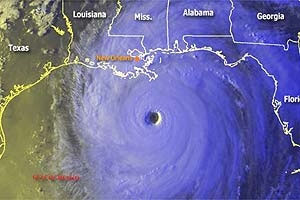
Unspecified Hurricane Headed for U.S. Central Gulf Coast |
|
These days we earthlings have access to all the information we want and can absorb on any and all topics by using that marvel called the internet. So says I, I'll make an inquiry of what the difference between a hurricane and a typhoon is on Google, that bottomless well of pertinent information. The search produced the following:
"The terms "hurricane" and "typhoon" are regionally specific names for a strong "tropical cyclone". A tropical cyclone is the generic term for a non-frontal synoptic scale low-pressure system over tropical or sub-tropical waters with organized convection (i.e. thunderstorm activity) and definite cyclonic surface wind circulation." |
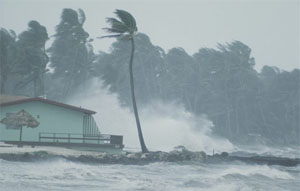
Florida House Being Assailed by a Hurricane |
|
OK, I'm an engineer by training but "non-frontal synoptic scale low-pressure system" did not grease my slide rule (if you're under 40 you may want to consult the engineering archives for what a slide rule is). Evidently "synoptic scale" means the storm is greater than 1,000 km wide and non-frontal = cyclone = spiral shaped devil like the one pictured above on the left, although that one is actually a hurricane.
The Spanish for a storm is simply "La Tormenta". Call it what you will but the storm that hit here on Tuesday the first of June, at times, was as strong as any hurricane I had experienced in the U.S. It was indeed a torment. A day later the true extent of the storm damage became evident. Much of the area including Quepos and particularly Manuel Antonio were without power, water, telephone or internet. Most services were returned to metropolitan (yuk,yuk) Quepos within 24 hours but the damage was so severe in Manuel Antonio that some areas were still without essential services three days later.
The busses,which routinely run every 20 minutes, stopped running to the National Park and beach and had to turn around at the top of the hill. The road down the south side of the mountain to these popular areas was virtually covered with downed trees and utility lines. Some of the trees were a meter or more in diameter. After it became apparent that it would take days, not hours to get back to normal, many tourists who had been staying in hotels on the south side of the mountain walked up the mountain with baggage trying to get to hotels on the other side or to central Quepos where there were services. The bus routes would not be back to normal for five days.
Here's a montage of pictures during and after the storm:
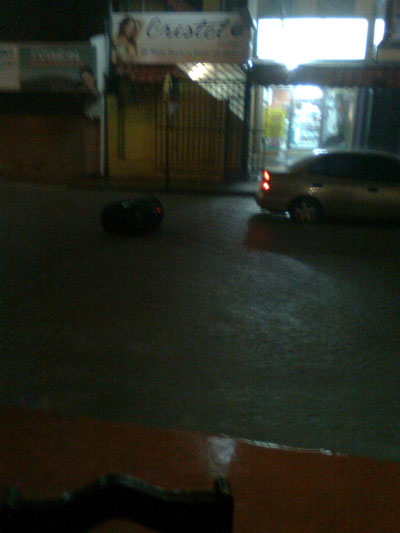
The ROMEOS were enjoying a couple of slices at Joker Pizza after sunset in downtown Quepos when the storm began. This view is from Joker towards Farmacia Economica across the street. That's Joker's trash barrel sailing down the street. Several of the streets in Quepos are below the level of this street and had already flooded severely. This picture was taken a few hours before the height of the storm. |
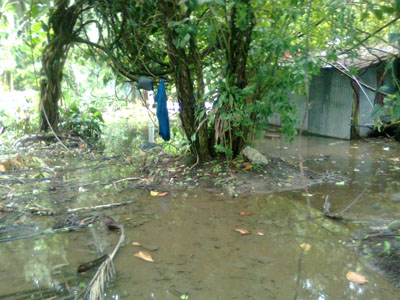
Remember our pal Palucca (see Episode 21), the gent who rents umbrellas and chairs at the beach? That's his cabin to the right five days after the storm. Palucca reported he was literally up to his chest in water and praying hard before the storm peaked. The main water damage here was not from the severe high tides caused by the storm but from the runoff in back of Palucca's place as huge amounts of water tried to drain down the mountain into the sea. |

This is a shot of the area in front of the main part of Manuel Antonio beach, also five days after the storm. Next to the pile of vegetation refuse is a substantial gorge cut out from water trying to get out of town. Considering the high tides swept in by the storm, it was surprising that more of the beach here hadn't eroded. Two of the ROMEOS took a ferry over to the Cocal area north of Quepos and on the other side of the Naranjo river on day+4 and inspected more serious erosion of the shore in that area. |
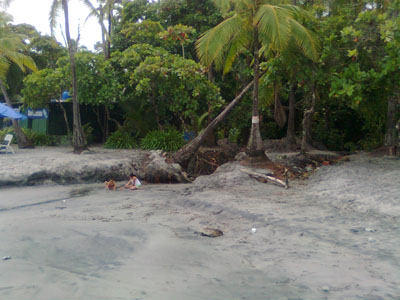
This is the gully in front of the Palucca Palace as seen from the beach side. It was formed by the tremendous rush of water across the road from Palucca's area and also from the base of the main mountain known as Manuel Antonio. The water simply uprooted a large palm tree and left it akimbo. |
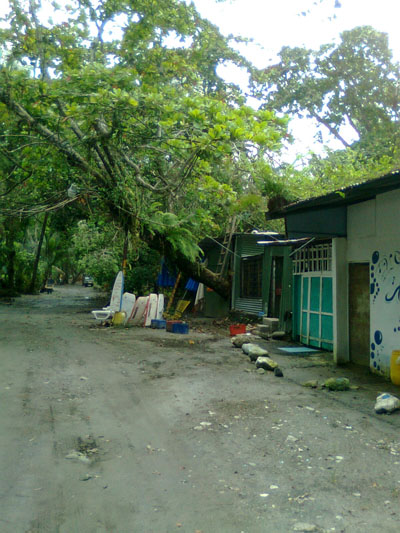
This is Palucca's shop for chairs, umbrellas and assorted flotation devices. The beach road here dead ends about 200 meters from the shop. His cabin is on the opposite side of the building. After the storm, his shop sported a rather large tree growing out of it's west side. Seems like an extreme version of a private home going "green". |
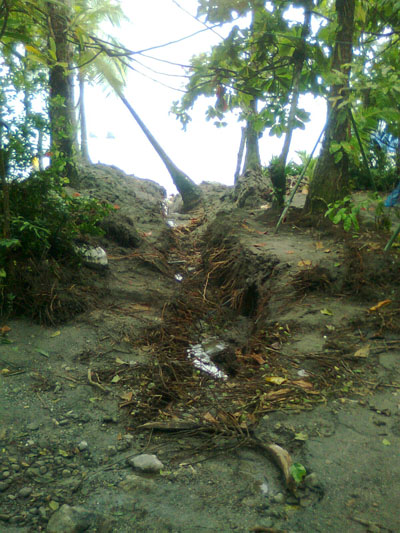
This is the same gully as that shown two pictures to the left, except from the road side. This area was originally essentially flat and sandy and provided a walking access to the beach. I can't imagine what kind of water flow caused this gully to be carved out.
Mucha, mucha agua, amigos. |
I mentioned to someone that this was the strongest storm I had ever experienced either in the year and a half I've been living here or in the eight times I had visited before moving here. She seconded the motion and said this was the strongest storm she had experienced in her 22 years living here. Enough, amigos, bring on the sun and let's get back to the beach. I have no idea what rainfall was measured at the Santa Rosa or any other station coming from this storm but I would not be surprised to learn that it was more than half a meter.
Early Sunday afternoon, five days after the storm, I happened to be waiting for a bus into town near the Mono Azul Hotel when I witnessed a caravan of a dozen or more ICE vehicles heading down Manuel Antonio road into Quepos. ICE or Instituto Costaricenses de Electricidad are the guys responsible for utilities services. I suspect this was a contingent of emergency reinforcements that were called in after the storm and that they were heading back to wherever their home bases are. Thanks for your help, amigos.
I hope to never experience a non-frontal synoptic scale low-pressure system like this one again.
Legislative Largesse
It seems politicians think the same no matter where they hail from, i.e., mostly about themselves.
In Costa Rica there are term limits on both assembly seats and the Presidency. Fifty seven Deputies make up the unicameral Asamblea. Both the presidency and the assembly recently changed hands (see Episode 22). For their first legislation, the new crowd of lawmakers decided to give themselves a 70 percent pay raise to about 4.5 million colons a month or about $8,400 per month at the current exchange rate. This would be in a country where the average wage is $400-600 per month. An internet source puts 2009 per capita income in Costa Rica at $10,529 and that in the U.S. of A. at $46,400. This would make the new C.R. legislative salary level $8,400 x 12 / $10,529 = 9.6 times the per capita income. The equivalent U.S. numbers are: (1) per capita income = $46,400, (2) annual congressional salary = $174,000; multiple = $174,000/$$46,400 = 3.8 (don't tell those U.S. Pols, they'll want a raise). Of course this doesn't take into account the perks and other benefits, which are substantial in both countries, but that's for another story.
Los Deputados in the Asamblea had approved the proposal in the first of two votes but President Laura Chinchilla sent a letter to key lawmakers saying that she would veto the proposal if it reached her desk. She called it a budget buster. I call it unbounded, self-perpetuating largesse towards themselves and arrogance on the part of government towards the citizenry. We'll see how the battle goes and who wins. There were citizen demonstrations in San Jose about this legislation. Rightly so, amigos.
On Tough Ticas

Hanna Gabriel - Tica Pugilista Extraordinaria
But Babe, Where's the Belt?
Never mind, It's Better Off Than On That Torso |
|
One thing our hero has noticed about Ticos is the high interest on the part of the public in women's sports. Occasionally we have boxing matches here in Quepos in the town square, which is now being made into a rectangular parking lot, and at festivals. For these events there are always a set of female boxers (see Episode 19 for more on festivals and boxing). Even the local indoor football hall in my neighborhood (barrio Los Angeles) routinely draws larger crowds for the female games than for the males. Either there is a real interest in female sports or a lot of randy males out there (well, never mind that train of thought, let's not go there).
OK, so Costa Rica may not have made the cut for the World Cup of Futbol however at least one Tica was busy working on another kind of world title. Costa Rican female boxer Hanna Gabriel brought home the world welterweight female boxing championship recently. She returned home from the matches in Puerto Rico sporting the 70-kilo women's world champion boxing belt (my belt feels that heavy sometimes).
The Costa Rica fighter caught opponent Gardy Pena of the Dominican Republic with two rights to the head at the start of the first round, and the fight was over in 11 seconds. (I think I met someone like Hanna in a bar back in the seventies - but again, let's not go there) The referee stopped the action because it was clear that Ms. Pena could not continue. Pow! Wham! Bam! Zowie! Good stuff, batwoman!
When Ms. Gabriel returned home she was the centerpiece of a motorcade to downtown San Jose from Juan Santamaría airport. In the past, Gabby held the title at the 67 kilo level but renounced it last December because she had trouble getting down to the maximum weight. Check the pic to the left - the higher weight is well worn, don't ya think?
Who needs an army when you've got Hannas. |
World Cup Futbol
The World Cup of Futbol (that's soccer to the Rio Lindans) rolls around every four years and this year the tournament is being held in South Africa for the first time. The tourney began in early June and will last until early July. The World Cup games were incomplete as of press time for this issue (oh, the pressure, the pressure of deadlines). The World Cup is sanctioned by FIFA (Federation Internationale Futbol Association - sounds like the French got in early and were allowed to name the thing).
The national teams are drawn from the best players in each country, regardless of local team affiliation. They play a number of international games over the years leading up to the tournament and in that way qualify for the World Cup Finals. This year all six (populated) continents are represented by the following 32 teams:
The thirty two teams are first organized into eight groups of four and each team plays the other three teams in its group for the first round. A team receives 3 points for a win and 1 point for a draw. The two teams with the highest points after the initial round of three games moves on to the next round of sixteen (called octavos since there are eight games for the round of sixteen) and from that point on a team must win every game to become champion. |

Senor Lio Messi - Reputed to be the world's best player. He leads the Barcelona club and the Spanish national team into the World Cup. His reported annual salary? 8.4 million Euros ($10.4 million)
I guess in the picture above Lio just scored (or maybe just received his paycheck). |
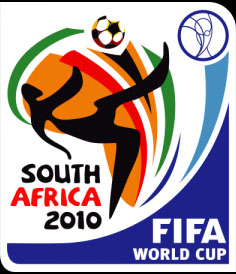
|
The CONCACAF division includes all the North American and Central American countries. It's nice to see the U.S. is in the tournament. Where are the Canadians, eh?. And where are my buddies from Costa Rica? I have to tread carefully here because I believe the U.S. team was partly responsible for Costa Rica not making the cut. Desculpen nosotros amigos. Maybe next year companeros, when we get the new stadium... (see Episode 20 for more on our new "Estadio Chino" in San Jose).
Note the long list of countries from Europe in the table above. Futbol in Europe is a passion beyond compare. I remember how ardent (that's a euphemism for drunk and disorderly) the fans were in Europe. They take no second place in this regard to U.S. football fans.
All the major European countries are represented at the World Cup as are a few of the smaller ones. Notably absent, my second adopted country, Belgium. They'll have to stay home and cry in their Stella Artois beers at the local pub - quelle triste, mes amis.
Since the tournament's inception in 1930, Brazil has won the World Cup five times; more than any other country . That's five out of eighteen possible (no games were played in 1942 and 1946 because of World War II). In addition Brazil has been in the money (runner up, third or fourth place) five other times.
So far the U.S. has only been in the top three victory positions one time, achieving third place in 1930 and, unfortunately, Costa Rica has not yet achieved a place in the money at the World Cup.
Guess you'll have to wait for the 2014 games, amigos. Maybe the new stadium... duh, I said that already.
|
Cristiano Rinaldo (below) gets a lot of press as futbol's "Pretty Boy". Cris works for the Real Madrid company in Spain but was originally from Portugal and led the Portuguese national team into the World Cup. He, like Lio Messi, must also play fairly well as his salary is $8.4 million per year at Real Madrid. You can be just a little prettier with that kind of tortilla dough, right Chris?.
|
.jpg) .jpg)
The FIFA World Cup Trophy and the Brazilian World Cup Team |
|
Miscellany
3 Other Tenors
So what is it about Italians (and to a lesser extent, the Irish) that produces so many great tenors. Maybe it's the olive oil that luxuriously lubricates the larynx, but whatever it is, I'm a sucker for strong voices. I use to love listening to "The Three Tenors" (Placido Domingo, Luciano Pavarotti and Jose Carreras) when they had their concerts on TV. OK, in reality only Pavarotti is Italian and the other two are Spanish - don't get picky; they use a lot of olive oil in Spain too, amigos.
Recently I came across another set of three tenors and was taken aback strongly by their unbelievable voices. And these dudes are only young teenagers!
Take four minutes and treat yourself - check them out here: Three Tenors.
Wow!
Double Take
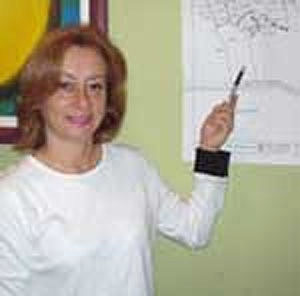
Angela Jimenez of Costa Rica
Architect/Certified Appraiser |
|
Have you ever heard it said that everyone has a double or a twin out there somewhere?
It's an age-old belief with a strange appeal that somewhere on this planet, alive today, is someone who looks like you -- maybe not precisely, but close enough to be your double, your doppelganger.
I was routinely wading through my email the other day reading pages in AM Costa Rica, an daily electronic English newsletter, when I was startled to see a picture of my oldest daughter Jenny (see Episode 22) in the advertisements bordering the second page (newsletter link = http://www.amcostarica.com/morenews.htm).
Wait! Why would Jenny be taking out ads in a C.R. newsletter? Yee gods, that's not her - but it is! No, really, it isn't, that's some babe named Angela Jimenez, an Architect/Appraiser. OK, mi amigos, judge for yourself from these pictures.
Of course, nothing against Angela but I think the real Jenny is cuter. |

|
R.O.M.E.O. Corner (Retired Old Men Eating Out)
Coconut Spice Restaurant (Dominical)
Dominical is a small town located about 44 kilometers (in Rio Linda that's 26 miles) south of Quepos on the Pacific Coast. It is a much smaller community than Quepos and is known primarily for its rugged country and excellent surfing beach (read angry water for a ROMEO). One wouldn't expect to find much of a restaurant, let alone a Thai restaurant in a place like Dominical. But then, what does one really know, amigo?
The restaurant is situated on the Rio Baru, a river that defines the northern limits of downtown Dominical. The river flows into the Pacific; the river and the Pacific can be seen from the restaurant's dining room. One time we visited, we could also see a couple of crocodiles sunning themselves on the opposite shore of the river. Walking the river's edge near the restaurant is not suggested unless you have many years experience as a croc trainer like me (yuk,yuk).
The menu is almost completely asian cuisine, so don't go there for a hamburger. There are 51 numbered dishes on the menu, which helps make ordering easier as many items have names like MOO GOO GAI PAN FUNG CHI WOUK , etc. Does anyone understand these titles except Asians? |
The Coconut Spice Restaurant - I have a bad habit of not cleaning the cell phone lens before taking a picture - gives it that mystical look. |
|
Most of the dishes also have pictures of the prepared dish. I've always thought this practice to be kinda silly as flavors don't come through the pictures. But I suspect letting the customer see up front what they're getting avoids vigorous discussion of whether or not that was the real dish they had ordered. I mean, ya better see what CHANG MAI KHAO KUNG PAD PRIK NASI KUNING looks like up front cause your not otherwise going to believe it's what you ordered when it arrives at table.
Among the fifty one items on the menu which are pictured and numbered (numbering makes it easier for Gringos and Ticos alike), are some of my favorite dishes:
- #18 PHAD THAI - Sweet sour noodles and vegetables with chicken or prawns. The delicate and mild sauce on this dish is truly excellent. Incidentally, you can have these dishes spiced to any degree of hotness you desire.
- #19 NASI GORENG - Indonesian chicken fried rice. A classic in many restaurants of this type and a favorite among Ticos as it very closely resembles arroz con pollo (also known as Tico fuel).
- #21 KAI MOO DAENG - Grilled pork served with rice, a hot tamarindo sauce and peanuts. Yummy.
- #33 MURGH KAJU - Yogurt marinated chicken, grilled and served in a cashew nut gravy. Haven't tried this yet - next time - also sounds yummy.
- #34 THAI GREEN CURRY - Chicken, pork or beef in a green curry sauce with vegetables. Also available in yellow and red curry versions.
Oh for crying out loud, just try anything and walk away happy.
The Coconut Spice deserves four sloths. |

|
Until next month, don't take any wooden colones, amigos.
Don Roberto de Quepos,
El Gringo Dorado
Pura Vida! |
|
|

